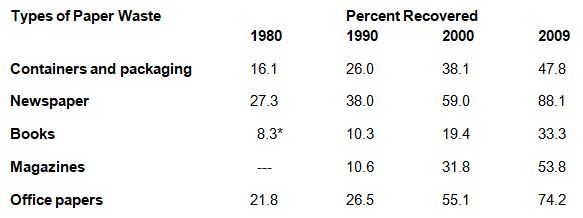Suppose that as a consequence of market changes, the selling price of recycled newspaper is $35 per ton. At this price level, is the market in an equilibrium, shortage, or surplus condition? Be sure to support with specific values.
THE MARKET FOR RECYCLED NEWSPRINT
The amount of trash generated in the United States has risen from 88.1 million tons in 1960 to 243.0 million tons in 2009. Of this tonnage, approximately 28.2 percent is paper and paperboard. In a logical move, many communities established paper recycling programs in the 1980s. The first step was to encourage individuals and firms to bring paper wastes to collection centers. According to EPA data, as shown in the accompanying table, this recovery stage has met with some success.

*The 8.3 in 1980 represents books and magazines, which were reported in the aggregate prior to 1990.
Although these data suggest that society responded responsibly, they belie a very real problem. Many communities failed to recognize the need to create a market for recovered materials. This was precisely the problem that arose during the late 1980s and continued into the 1990s. The result was insufficient demand for recovered newspapers, and the excess supply sent the price of used newsprint plummeting.
To correct the problem, it was necessary to stimulate market demand. Virtually all levels of government took an active role. A number of state governments passed laws requiring newspapers to be partly printed on recycled paper. At the federal level, President Clinton signed Executive Order 12873, calling for all printing and writing paper to contain at least 20 percent recovered paper. (This amount was subsequently raised to 30 percent in Executive Order 13101.) The EPA established clearinghouses and hotlines to bring together suppliers and demanders of recyclables. Added influences were the thriving domestic economy and the rising demand of developing nations, whose growth required new sources of paper inputs.
Taken together, market demand eventually swamped existing supplies, and in 1995, there was a shortage of recycled newsprint. Just as predicted by economic theory, the shortage placed upward pressure on price, which rose to between $100 and $200 per ton. The boom in the market was temporary, however. By 1996, excess supplies and falling demand drove prices back to the $20 per ton level of the early 1990s.
Such volatility is characteristic of this market and continues through the present day. As a case in point, assume that the market demand for recycled newsprint in 2011 is QD = 200 – 2P and that market supply is QS = –150 + 5P, where P is the price per ton and Q is the quantity in thousands of tons per year.
If the market price per ton of recycled newsprint is $35, the quantity demanded would be QD = 200 – 2(35) = 130 thousand tons, while the quantity supplied would be QS = –150 + 5(35) = 25 thousand tons. Since QDexceeds QS, there is a shortage equal to QD– QS = 130 – 25 = 105 thousand tons.
You might also like to view...
If the price of a DVD falls,
i. the demand curve for DVDs will shift rightward. ii. the demand curve for DVDs will not shift. iii. there will be a movement along the demand curve for DVDs. A) i only B) ii only C) iii only D) ii and iii E) i and iii
A low exchange rate for the dollar makes foreign currencies:
A. more expensive, raising the price of imports. B. more expensive, lowering the price of imports. C. cheaper, lowering the price of imports. D. cheaper, raising the price of imports.
A decrease in the cost of production will shift the supply curve down and to the right.
Answer the following statement true (T) or false (F)
Changes in U.S. citizens' holdings of long-term financial and physical assets in another country are reported in
A. the capital account. B. total exports of goods and services. C. the current account. D. the trade balance.